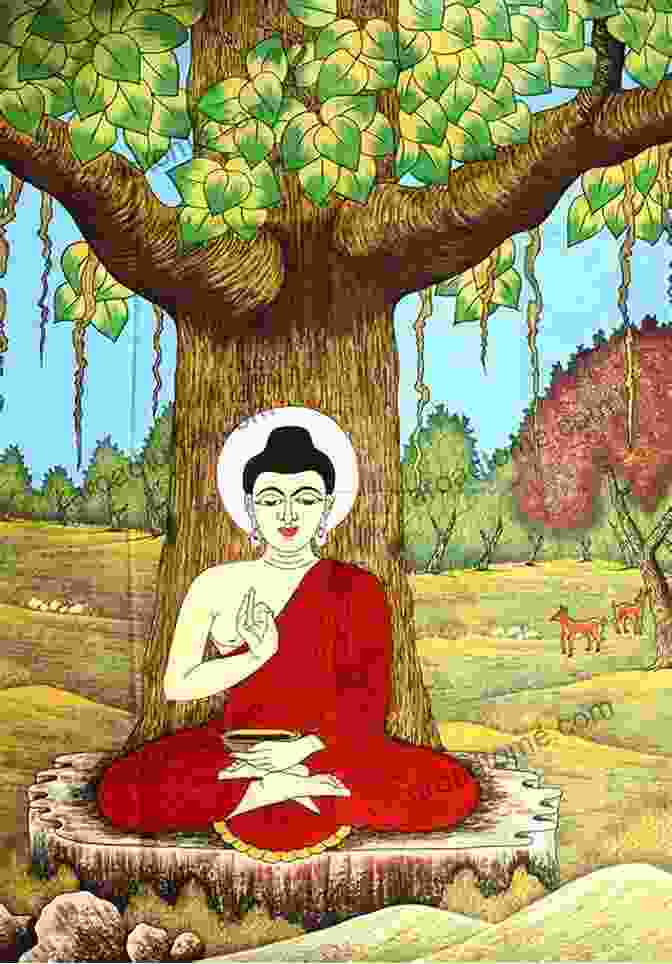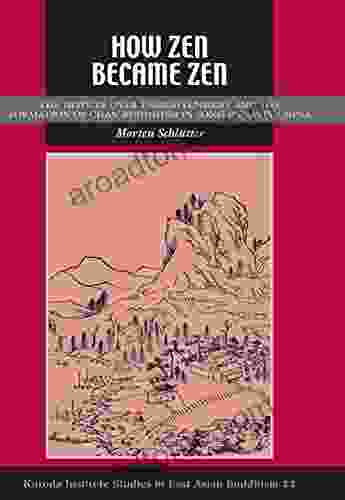How Zen Became Zen: A Journey into the Heart of Buddhism's Most Enigmatic School

In the annals of spiritual traditions, Zen Buddhism stands apart as a profound and enigmatic school of thought, its teachings steeped in paradox and its practices cloaked in mystery. Yet, beneath this enigmatic exterior lies a rich and fascinating history that has captivated scholars and practitioners alike.
4 out of 5
| Language | : | English |
| File size | : | 1352 KB |
| Text-to-Speech | : | Enabled |
| Screen Reader | : | Supported |
| Enhanced typesetting | : | Enabled |
| Print length | : | 357 pages |
In "How Zen Became Zen," acclaimed historian and Zen scholar James H. Fotopoulos delves deep into the origins and evolution of Zen Buddhism, tracing its remarkable transformation from a nascent movement in ancient India to its present-day global reach.

The Seeds of Zen: Buddhism's Indian Roots
Zen's roots can be traced back to the teachings of the historical Buddha, Siddhartha Gautama, who lived and taught in northern India during the 6th century BCE. The Buddha's central message focused on the Four Noble Truths, which recognized the existence of suffering, its causes, its cessation, and the path to its end.
As Buddhism spread throughout India, it encountered diverse philosophical and religious influences, leading to the development of numerous sects and schools. Among these, the Mahayana tradition emerged as a significant force, emphasizing compassion, emptiness, and the bodhisattva ideal of selfless dedication to the enlightenment of all beings.
The Zen Revolution: Transmission to China
In the 5th century CE, a renowned Indian monk named Bodhidharma traveled to China and is credited with introducing the teachings of Zen to the Far East. According to legend, Bodhidharma spent nine years meditating silently in a cave at Shaolin Temple, his unwavering gaze piercing through the wall. This act symbolized the radical shift in Zen practice, which emphasized direct experience and sudden enlightenment over scriptural study and ritual.

Under the leadership of Bodhidharma and his successors, Zen flourished in China, becoming known as Chan Buddhism. Chan masters developed innovative teaching methods, such as the use of koans (paradoxical riddles) and the practice of silent meditation (zazen). These methods aimed to break through conventional thinking and lead students directly to the experience of enlightenment.
The Spread of Zen: From China to Japan
By the 12th century, Zen had spread widely throughout China, becoming a dominant force in Chinese culture. However, its most profound impact was yet to come as it crossed the East China Sea to Japan.
In Japan, Zen found fertile ground, resonating deeply with the Japanese samurai ethos of self-discipline and unwavering focus. Zen masters taught samurai the art of mindfulness and meditation, which enhanced their martial prowess and helped them cultivate a calm and centered mind in the face of battle.

Zen also played a significant role in Japanese art and culture, inspiring the development of haiku poetry, ink painting, and the tea ceremony. These artistic expressions reflected Zen's key principles of simplicity, spontaneity, and appreciation of the present moment.
The Modern Revival: Zen's Global Influence
In the 20th century, Zen Buddhism experienced a resurgence of interest in the West. Western scholars and practitioners were captivated by Zen's enigmatic teachings and transformative potential. Zen centers and meditation retreats sprang up across Europe and North America, attracting a growing number of seekers.
Today, Zen Buddhism continues to spread its influence globally, offering individuals a path to self-discovery, inner peace, and awakened consciousness. Its teachings have found resonance in diverse fields, such as psychology, psychotherapy, and creativity, demonstrating the enduring relevance of Zen's wisdom in the modern world.
"How Zen Became Zen" is an invaluable companion for anyone seeking a deeper understanding of Zen Buddhism. James H. Fotopoulos' meticulous research and engaging narrative bring to life the captivating history of this enigmatic tradition, from its Indian roots to its profound influence on Chinese and Japanese culture. Through its pages, readers will discover the essence of Zen's teachings, its transformative practices, and its enduring legacy as a path to enlightenment and inner peace.
4 out of 5
| Language | : | English |
| File size | : | 1352 KB |
| Text-to-Speech | : | Enabled |
| Screen Reader | : | Supported |
| Enhanced typesetting | : | Enabled |
| Print length | : | 357 pages |
Do you want to contribute by writing guest posts on this blog?
Please contact us and send us a resume of previous articles that you have written.
 Book
Book Novel
Novel Page
Page Chapter
Chapter Text
Text Story
Story Genre
Genre Reader
Reader Library
Library Paperback
Paperback E-book
E-book Magazine
Magazine Newspaper
Newspaper Paragraph
Paragraph Sentence
Sentence Bookmark
Bookmark Shelf
Shelf Glossary
Glossary Bibliography
Bibliography Foreword
Foreword Preface
Preface Synopsis
Synopsis Annotation
Annotation Footnote
Footnote Manuscript
Manuscript Scroll
Scroll Codex
Codex Tome
Tome Bestseller
Bestseller Classics
Classics Library card
Library card Narrative
Narrative Biography
Biography Autobiography
Autobiography Memoir
Memoir Reference
Reference Encyclopedia
Encyclopedia Suzanne Barton
Suzanne Barton Jonah Lehrer
Jonah Lehrer Sue Hanks Singleton
Sue Hanks Singleton Zell Miller
Zell Miller Yung Pueblo
Yung Pueblo Vincent Brown
Vincent Brown Scott M Burnstein
Scott M Burnstein Stephen Jorgensen
Stephen Jorgensen Swami Sivananda Radha
Swami Sivananda Radha Jon G Hughes
Jon G Hughes Tommie Kelly
Tommie Kelly Star Modez
Star Modez Sputnik Futures
Sputnik Futures Wendy Northcutt
Wendy Northcutt Sarah Poriss
Sarah Poriss Steven Karras
Steven Karras T Agami Reddy
T Agami Reddy Sharlee Dimenichi
Sharlee Dimenichi Summerita Rhayne
Summerita Rhayne Latham Thomas
Latham Thomas
Light bulbAdvertise smarter! Our strategic ad space ensures maximum exposure. Reserve your spot today!

 Clayton HayesUnleash the Power of the Blackmar-Diemer Gambit Accepted with Our Exclusive...
Clayton HayesUnleash the Power of the Blackmar-Diemer Gambit Accepted with Our Exclusive... Percy Bysshe ShelleyFollow ·14.7k
Percy Bysshe ShelleyFollow ·14.7k Howard BlairFollow ·3.7k
Howard BlairFollow ·3.7k Jeffrey HayesFollow ·4.2k
Jeffrey HayesFollow ·4.2k Charlie ScottFollow ·2.1k
Charlie ScottFollow ·2.1k Herman MitchellFollow ·18k
Herman MitchellFollow ·18k Vincent MitchellFollow ·3.4k
Vincent MitchellFollow ·3.4k Alexandre DumasFollow ·12k
Alexandre DumasFollow ·12k Harvey HughesFollow ·6.7k
Harvey HughesFollow ·6.7k

 Timothy Ward
Timothy WardSteamy Reverse Harem with MFM Threesome: Our Fae Queen
By [Author...

 Cody Blair
Cody BlairThe Ultimate Guide to Energetic Materials: Detonation and...
Energetic materials are a fascinating and...

 Kenzaburō Ōe
Kenzaburō ŌeProstitution, Modernity, and the Making of the Cuban...
By Emily A....

 Kirk Hayes
Kirk HayesUnveil the Enchanting World of The Rape of the Lock by...
Alexander Pope's epic...

 Ivan Turgenev
Ivan TurgenevTantric Quest: An Encounter With Absolute Love
Embark on a Tantric Quest to...

 Gary Reed
Gary ReedThe Darwin Awards: Evolution in Action
The Darwin Awards are a...
4 out of 5
| Language | : | English |
| File size | : | 1352 KB |
| Text-to-Speech | : | Enabled |
| Screen Reader | : | Supported |
| Enhanced typesetting | : | Enabled |
| Print length | : | 357 pages |










